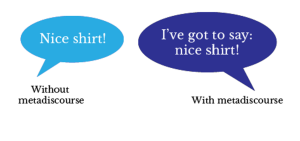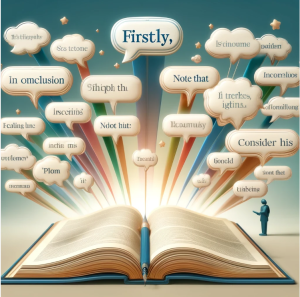31 How Do I Use Metadiscourse to Show I’m Human?
This section is remixed from “Metadiscourse” by Conrad Van Dyk, licensed CC BY NC SA 4.0
Even if you’ve only ever written a single essay–or even a line of an essay–you’ll be familiar with metadiscourse and the challenge it presents. Metadiscourse is a fancy word for the language we use to frame our ideas:

It’s hard to write without using metadiscourse. For instance, anytime you indicate a change in direction, you end up using expressions like however, or on the other hand. These transitional expressions are examples of metadiscourse.
Use too much of this kind of language and your prose will seem stilted and dry; use too little and the reader will be lost in a jungle of disconnected observations. When used appropriately, metadiscourse can frame your ideas effectively.
Definition
The word metadiscourse consists of two parts. The word discourse means communication or debate. The prefix meta comes from Greek and means about. In other words, metadiscourse refers to the language we use to talk about our regular communication. When your friends comment on a meme that is self-referential, for example, they may say “That’s so meta!”
In short, metadiscourse is writing about writing. Metadiscourse is important because it allows us to give direction and relate the various parts of our essay to each other and to the whole.
Here’s how one scholar defines metadiscourse:
Essentially metadiscourse embodies the idea that communication is more than just the exchange of information, goods or services, but also involves the personalities, attitudes and assumptions of those who are communicating. (Hyland 3)
In other words, your choice of metadiscourse affects your writing style. It affects how readers perceive you as a person and as a writer.
Editing with Metadiscourse

Here’s a sample essay introduction filled with metadiscourse:
When comparing two pieces of literature, there are many different aspects that a person can analyze. When we take a closer look at Philip Pullman’s The Golden Compass or C. S. Lewis’s The Lion, The Witch and the Wardrobe we see that this is true. For example, Lewis shares a Christian message, whereas Pullman promotes an atheist worldview. In this essay, I will demonstrate that these themes come up especially in relation to lying. Whereas Lewis condemns Edmund for being a liar, Pullman makes his heroine, Lyra, an accomplished liar and praises her for it.
Clearly this paragraph is very self-referential. The writer constantly reminds us that literary analysis involves comparison, analysis, close reading, and argumentation. Much of this language is redundant, and we could easily do with a shorter version:
Philip Pullman wrote The Golden Compass in part because he hated C. S. Lewis’s The Lion, The Witch and the Wardrobe. Whereas Lewis shares a Christian message, Pullman promotes an atheist worldview. We see this especially when it comes to lying. Lewis condemns Edmund for being a liar, but Pullman makes his heroine, Lyra, an accomplished liar and praises her for it.
The revised version is more direct. By minimizing the frame we can focus on the picture.
The point, then, is that metadiscourse should be used judiciously. Some writing instructors go overboard and launch a crusade against metadiscourse, deleting as much self-referential language as they can. Instead, the challenge is to find a happy medium, where your metadiscourse makes the reading process smooth and easy.
Finding Your Voice: Using “I” in Metadiscourse
Using metadiscourse effectively starts with finding your own voice. Writers often struggle to decide what pronouns to use (or whether to use them at all). Let’s review whether it’s acceptable to use “I” and “we” in academic writing.
I can’t tell you how often students have come to me and said “But my teacher told me never to use ‘I’ in my essay.” While such advice may be well-meant, it has the unfortunate effect of making the act of writing seem somehow impersonal and distant, as if essays have to be composed in a different language.
Now it is true that “I” is often redundant. If you’re writing a book review and you open with “I think that Slade House was a gripping read” you could just as well say “Slade House was a gripping read.” The reader will assume that the statements on the page are your opinion.
Despite these caveats, using “I” is not forbidden, and is often preferred because it allows you to write actively instead of passively. The first person voice is particularly useful when you’re distinguishing your ideas from those of others (they say/I say):
Whereas Sarah Jones argues that … I would suggest that …
I agree with Michael Smith that …
The first person pronoun is also useful for indicating shifts in your argument:
I will argue that …
Having seen that … , I think we can safely conclude that …
Even if you later decide to delete some of those “I’s,” they will have helped you to get your ideas on paper, and that’s a good thing.
Another pronoun that tends to confuse writers is “we.” Here’s how to use “we” without sounding pompous.
First, avoid using the “royal we,” where “we” is just a grander way of saying “I”:
We will argue that …
As we have demonstrated …
Unless you are coauthoring a piece of writing, this use of “we” is not advisable.
On the other hand, you can use “we” if you’re actually referring to multiple individuals:
In our study group we found that …
As we examine the evidence, we will see …
Notice that in the second example “we” refers to the writer and the reader(s). This use of the pronoun can be an effective way of making your audience feel part of the process.
Conclusion
Much of essay writing consists of learning to use metadiscourse properly. It’s about discovering your own voice, of developing your writing personality.
At first the tendency will be to do too much, to start every sentence with a transitional word (therefore, thus, etc.), or to add unnecessary modifiers (e.g., essentially). Then the pendulum might swing the other way, and you feel self-conscious every time you write “I will argue,” or “we will see.” This is one error I frequently notice in AI-generated texts. Instead of giving me a thesis statement that makes an argument, instead, the thesis “announces.” In this case, you should remove the metadiscourse “I will argue” or “This essay will argue” and instead, just make the argument.
In the end, what matters is that you find the right style for you.
You Try It!
Generative AI tools do some interesting things with metadiscourse. Sometimes they use too much, as when they “write” thesis statements that announce. But often, they write too little, so we don’t see the context of who you are as a human writer. If you’re working with an AI-generated rough draft, it’s especially important to use metadiscourse to “humanize” the writing and make sure it reflects both your ideas and your voice. For example, in my essay about OpenAI’s October 2024 Educator Forum, “What Would Truly Open AI Look Like?”, I digress with a weird little anecdote worrying that I left my curling iron on while I was trying to pay attention to the presenter. But it’s precisely this type of anecdote that marks my writing as human. A generative AI tool will not tell this story or provide this context.
For this exercise, I want you to flip the script. Write a prompt asking a generative AI tool to “write” a paragraph on your problem or your solution. Then revise using your own metadiscourse to humanize the paragraph. Reflect on your process. How does it feel to co-write with AI in this way?

